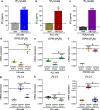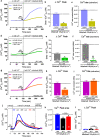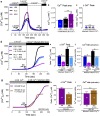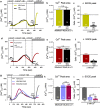Mibefradil alters intracellular calcium concentration by activation of phospholipase C and IP3 receptor function
- PMID: 35006468
- PMCID: PMC8607413
- DOI: 10.1186/s43556-021-00037-0
Mibefradil alters intracellular calcium concentration by activation of phospholipase C and IP3 receptor function
Abstract
Mibefradil is a tetralol derivative originally developed as an antagonist of T-type voltage-gated calcium (Ca2+) channels to treat hypertension when used at nanomolar dosage. More recently, its therapeutic application in hypertension has declined and has been instead repurposed as a treatment of cancer cell proliferation and solid tumor growth. Beyond its function as a Cav blocker, the micromolar concentration of mibefradil can stimulate a rise in [Ca2+]cyt although the mechanism is poorly known. The chanzyme TRPM7 (transient receptor potential melastanin 7), the release of intracellular Ca2+ pools, and Ca2+ influx by ORAI channels have been associated with the increase in [Ca2+]cyt triggered by mibefradil. This study aims to investigate the cellular targets and pathways associated with mibefradil's effect on [Ca2+]cyt. To address these questions, we monitored changes in [Ca2+]cyt in the specialized mouse epithelial cells (LS8 and ALC) and the widely used HEK-293 cells by stimulating these cells with mibefradil (0.1 μM to 100 μM). We show that mibefradil elicits an increase in [Ca2+]cyt at concentrations above 10 μM (IC50 around 50 μM) and a fast Ca2+ increase capacity at 100 μM. We found that inhibiting IP3 receptors, depleting the ER-Ca2+ stores, or blocking phospholipase C (PLC), significantly decreased the capacity of mibefradil to elevate [Ca2+]cyt. Moreover, the transient application of 100 μM mibefradil triggered Ca2+ influx by store-operated Ca2+ entry (SOCE) mediated by the ORAI channels. Our findings reveal that IP3R and PLC are potential new targets of mibefradil offering novel insights into the effects of this drug.
Keywords: ALC cells; Ca2+ signaling; Cav; HEK293 cells; LS8 cells; Mibefradil; PLC pathway.
© 2021. The Author(s).
Conflict of interest statement
The authors declare no conflict of interest.
Figures





Similar articles
-
Mibefradil, a T-type Ca2+ channel blocker also blocks Orai channels by action at the extracellular surface.Br J Pharmacol. 2019 Oct;176(19):3845-3856. doi: 10.1111/bph.14788. Epub 2019 Aug 19. Br J Pharmacol. 2019. PMID: 31271653 Free PMC article.
-
TRPM7 activation potentiates SOCE in enamel cells but requires ORAI.Cell Calcium. 2020 May;87:102187. doi: 10.1016/j.ceca.2020.102187. Epub 2020 Feb 28. Cell Calcium. 2020. PMID: 32146159 Free PMC article.
-
The polyphenol ellagic acid exerts anti-inflammatory actions via disruption of store-operated calcium entry (SOCE) pathway activators and coupling mediators.Eur J Pharmacol. 2020 May 15;875:173036. doi: 10.1016/j.ejphar.2020.173036. Epub 2020 Feb 23. Eur J Pharmacol. 2020. PMID: 32101765
-
IP3 receptors and Ca2+ entry.Biochim Biophys Acta Mol Cell Res. 2019 Jul;1866(7):1092-1100. doi: 10.1016/j.bbamcr.2018.11.007. Epub 2018 Nov 15. Biochim Biophys Acta Mol Cell Res. 2019. PMID: 30448464 Review.
-
Role of Ca2+ signaling in the regulation of endothelial permeability.Vascul Pharmacol. 2002 Nov;39(4-5):173-85. doi: 10.1016/s1537-1891(03)00007-7. Vascul Pharmacol. 2002. PMID: 12747958 Review.
Cited by
-
PMCA Ca2+ clearance in dental enamel cells depends on the magnitude of cytosolic Ca2.FASEB J. 2023 Jan;37(1):e22679. doi: 10.1096/fj.202201291R. FASEB J. 2023. PMID: 36515675 Free PMC article.
-
Na+/Ca2+ exchange in enamel cells is dominated by the K+-dependent NCKX exchanger.J Gen Physiol. 2024 Jan 1;156(1):e202313372. doi: 10.1085/jgp.202313372. Epub 2023 Nov 10. J Gen Physiol. 2024. PMID: 37947795 Free PMC article.
-
Sex and age affect depot expression of Ca2+ channels in rat white fat adipocytes.J Mol Endocrinol. 2024 Feb 28;72(4):e230108. doi: 10.1530/JME-23-0108. Print 2024 May 1. J Mol Endocrinol. 2024. PMID: 38299791 Free PMC article.
-
Fatty Oil of Descurainia Sophia Nanoparticles Improve Monocrotaline-Induced Pulmonary Hypertension in Rats Through PLC/IP3R/Ca2+ Signaling Pathway.Int J Nanomedicine. 2023 Dec 8;18:7483-7503. doi: 10.2147/IJN.S436866. eCollection 2023. Int J Nanomedicine. 2023. PMID: 38090366 Free PMC article.
-
Ca2+ dynamics in interstitial cells: foundational mechanisms for the motor patterns in the gastrointestinal tract.Physiol Rev. 2024 Jan 1;104(1):329-398. doi: 10.1152/physrev.00036.2022. Epub 2023 Aug 10. Physiol Rev. 2024. PMID: 37561138 Free PMC article. Review.
References
-
- Wiltshire HR, Sutton BM, Heeps G, Betty AM, Angus DW, Harris SR, et al. Metabolism of the calcium antagonist, mibefradil (POSICOR, Ro 40-5967). Part III. Comparative pharmacokinetics of mibefradil and its major metabolites in rat, marmoset, cynomolgus monkey and man. Xenobiotica. 1997;27(6):557–571. doi: 10.1080/004982597240343. - DOI - PubMed
Grants and funding
LinkOut - more resources
Full Text Sources
Miscellaneous
